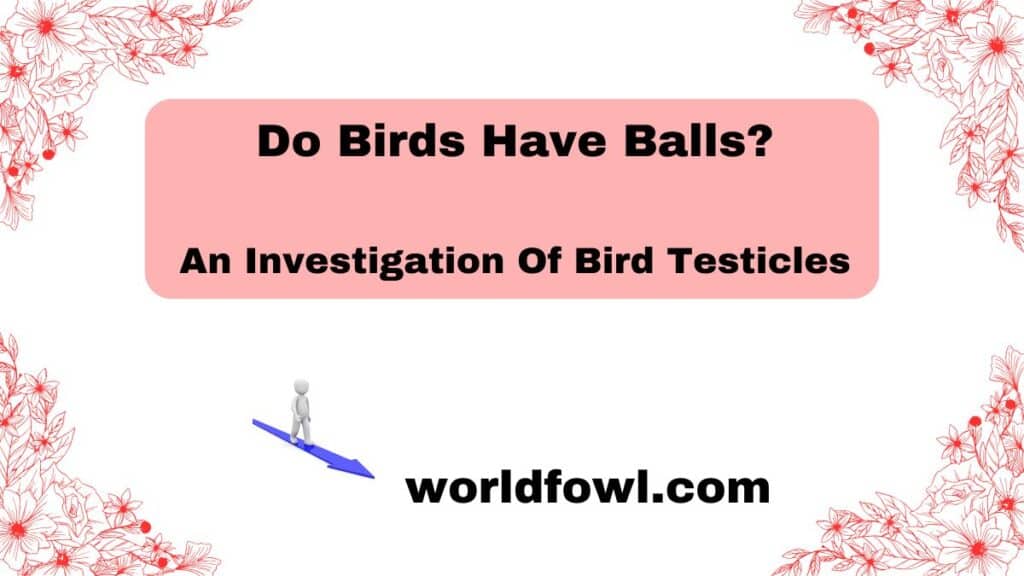Understanding Bird Anatomy: Do Birds Have Testicles?
When it comes to avian biology, a common question arises: Do Birds Have Testicles? The answer is unequivocally yes—male birds do indeed have testicles, but their anatomical positioning and function differ dramatically from those of mammals. Unlike most mammals, which have external testicles, birds possess internal testicles located within their bodies. This unique adaptation raises fascinating questions about their reproductive strategies, evolutionary significance, and overall anatomy.
Why This Matters
Understanding the anatomy of birds, including the role and function of their testicles, is crucial not only for ornithologists but also for anyone interested in animal behavior, evolution, and biology. The study of bird testicles can shed light on reproductive strategies, mating systems, and even the ecological dynamics within various bird species.
Do All Birds Have Testicles?
Yes, all male birds possess testicles, but the size, shape, and functionality can vary significantly among species. Generally, avian testicles are small, often resembling elongated beans, and are typically found within the abdominal cavity. This internal positioning serves several essential functions, especially related to flight and reproduction.
Size Variability Among Bird Species
The size of testicles can vary widely among bird species, largely depending on their mating systems. For instance, species known for sperm competition, such as many passerines (songbirds), often exhibit larger testicles relative to their body size. Conversely, monogamous species with less competition may have smaller testicles. Here are some notable examples:
- House Sparrow: Males exhibit relatively large testicles due to their competitive breeding strategies. In fact, research has shown that in environments with more competition, the testicle size can increase to enhance reproductive success.
- Swans: These birds often have smaller testicles, aligning with their generally monogamous mating systems. In swans, the need for large testicles is diminished because of the low level of sperm competition.
- Blue Jay: With a mating system that leans toward monogamy but allows for some extra-pair copulations, blue jays display moderately sized testicles, providing a balance between the need for competition and the energy investment in reproduction.
you may also like : What is a Group of Turkeys Called?
Evolutionary Implications
The variations in testicle size and structure among bird species are not just incidental; they reflect evolutionary adaptations to specific reproductive strategies. By studying these differences, researchers can gain insights into how environmental pressures shape the anatomy and behavior of different bird species.
Where Are Bird Testicles Located?
Bird testicles are located within the abdominal cavity, which is a significant departure from mammals, where they reside in an external pouch called the scrotum. This internal location is primarily an evolutionary adaptation that aids in aerodynamics and reduces drag during flight.
Internal Positioning Advantages
- Aerodynamics: Keeping testicles internal allows birds to maintain a streamlined body shape, which is crucial for efficient flight. This adaptation is especially vital for migratory species that travel long distances, as any extra weight can hinder their ability to soar.
- Thermoregulation: Birds regulate their body temperature through other means, such as feathers, which helps maintain optimal conditions for sperm production without the need for external testicles. This is particularly important since birds have a higher metabolic rate than many other animals, requiring efficient internal temperature control.
- Protection: Internal testicles are less vulnerable to environmental hazards, such as injury from predators or extreme temperatures, providing an evolutionary advantage. This protection is essential for species that inhabit habitats with higher risks of physical damage.
Anatomical Description
In most birds, the testicles are located near the kidneys, and their position can shift slightly during the breeding season. In some species, the testicles can actually expand considerably, moving slightly closer to the cloaca in preparation for mating. This anatomical flexibility illustrates the complex interplay between form and function in avian reproductive systems.
Why Do Male Birds Need Testicles?
Testicles play a crucial role in male birds’ reproductive success by producing sperm and secreting hormones, primarily testosterone. This hormone is essential for various physiological processes, including mating behaviors, aggression, and secondary sexual characteristics.
you may also like : Can Birds Eat Chia Seeds? (And Should They?)
Functions of Bird Testicles
- Sperm Production: The primary function of testicles in male birds is to produce sperm, which is essential for fertilizing eggs during reproduction. The quantity and quality of sperm can significantly influence reproductive success. For instance, studies indicate that male birds with larger testicles produce more sperm, which can be a critical advantage in environments where multiple males compete for the attention of a single female.
- Hormonal Regulation: Testicles also produce hormones like testosterone, which regulate behaviors associated with mating, such as territorial displays, courtship rituals, and aggression toward rivals. Higher testosterone levels can lead to more pronounced secondary sexual characteristics, such as brighter plumage or more elaborate displays, which are often critical for attracting mates.
- Seasonal Changes: During the breeding season, male birds often experience physiological changes that prepare them for mating. This includes testicle enlargement and increased sperm production, driven by hormonal fluctuations. Understanding these changes helps illuminate the dynamic nature of avian reproduction.
Hormonal Fluctuations
The changes in hormone levels during the breeding season are fascinating. For example, research shows that as day length increases in spring, many birds experience a surge in testosterone that leads to physical changes, such as the development of bright plumage or enhanced vocalizations to attract mates.
Why Are a Bird’s Balls Internal?
The internalization of bird testicles represents a remarkable evolutionary adaptation that serves multiple purposes, particularly in relation to flight.
Reduce Drag
The streamlined bodies of birds are crucial for their ability to fly efficiently. Internal testicles eliminate additional weight and bulk that external testicles would create. This design feature minimizes drag, allowing birds to conserve energy while flying. For birds that migrate long distances, such as the Arctic Tern, maintaining an optimal body shape is essential for survival.
Testicle Protection
Having testicles located within the abdominal cavity offers protection against potential injuries. External testicles are more vulnerable to damage from predators, environmental factors, and even social interactions with other birds. By internalizing testicles, birds enhance their reproductive chances and overall survival.
Evolutionary Perspective
From an evolutionary standpoint, the development of internal testicles likely occurred as birds adapted to their environments. The need for efficient flight, protection from predation, and successful reproduction all contributed to this anatomical adaptation. This evolution reflects the challenges birds face and their successful strategies to overcome them.
How Big Are Bird Balls?
The size of bird testicles varies significantly among species, influenced by mating systems and reproductive strategies.
Comparative Testicle Sizes
| Bird Species | Testicle Size (Relative to Body) | Mating System |
| House Sparrow | Relatively Large | Polygynous |
| Blue Jay | Moderate | Monogamous |
| Swans | Small | Monogamous |
| Peafowl | Large | Polygynous |
| Common Eider | Small | Polygynous |
| European Starling | Large | Polygynous |
Breeding Season Testicle Enlargement
Many bird species exhibit significant testicle enlargement during the breeding season. This phenomenon is tied to the need for increased sperm production and is driven by hormonal changes.
- Hormonal Influence: Increased levels of testosterone during the breeding season lead to physical changes in testicle size, often doubling or even tripling in some species. This size increase can be quite remarkable and plays a vital role in reproductive success.
- Environmental Cues: Changes in daylight hours and temperature can trigger hormonal shifts, signaling the onset of the breeding season. For example, the lengthening days of spring prompt hormonal changes that prepare birds for mating.
- Sperm Production Rates: As testicles enlarge, so too does the production of sperm. Research indicates that males of some species can produce millions of sperm each day during peak breeding times, underscoring the competitive nature of reproduction in birds.
you may also like : Do Seagulls Migrate? – The Hidden Abilities Of Gulls
Case Studies in Testicle Size
- European Starling: In starlings, researchers have observed that during peak breeding seasons, testicles can increase in size up to 300%. This dramatic change illustrates the importance of adapting to competitive reproductive environments.
- Red-winged Blackbird: Males have been shown to increase their testicle size significantly during the breeding season, correlating with their increased aggression toward rivals and heightened mating displays.
How Do Males Know When It’s Breeding Season?
Birds utilize a combination of environmental cues to determine when to initiate their breeding activities. These cues can include changes in temperature, daylight hours, and even the behaviors of other birds in the area.
Photoperiodism
Photoperiodism refers to the physiological reaction of organisms to the length of day or night. In birds, increasing daylight triggers hormonal changes that signal the start of the breeding season. This biological clock plays a crucial role in synchronizing reproductive activities across populations.
- Hormonal Responses: As daylight increases, it leads to elevated levels of hormones such as testosterone and luteinizing hormone, promoting the physical changes necessary for reproduction.
- Synchronization: Many species breed around the same time, utilizing these environmental cues to ensure that the availability of resources aligns with their reproductive efforts.
Temperature and Weather Patterns
Rising temperatures and favorable weather conditions also signal the approach of the breeding season. Birds often respond to these environmental changes by adjusting their reproductive behaviors, such as establishing territories, attracting mates, and initiating nesting activities.
- Food Availability: Warmer temperatures often coincide with increased food availability, providing crucial resources for breeding pairs. Birds that time their breeding season with food abundance can enhance their offspring’s chances of survival.
- Climate Change Impacts: With changing climate conditions, the timing of breeding seasons may also shift, leading to mismatches between food availability and reproductive timing. Understanding these dynamics is essential for conservation efforts.
Social Cues
Birds also observe the behaviors of their peers. For instance, the arrival of migratory birds or the initiation of courtship displays by neighboring males can prompt others to begin their breeding activities.
- Territoriality: The presence of competing males may encourage others to establish territories early, ensuring access to resources and potential mates.
- Courtship Rituals: The display of courtship behaviors by one male can stimulate others to respond similarly, fostering a communal breeding environment.
you may also like : Finches In Texas – The Complete Guide To Texas Finches
Are Bird Testicles Uniform in Size and Shape?
The short answer is no; bird testicles exhibit significant variation in size and shape, influenced by a range of factors, including mating systems, environmental conditions, and evolutionary pressures.
Differences in Size and Shape
- Species-Specific Variation: Each bird species has evolved unique adaptations that impact testicle size and shape. For example, species with high sperm competition tend to have larger testicles, while those with monogamous mating systems may have smaller, more uniform testicles.
- Shape and Texture: The shape of bird testicles can also vary, with some species exhibiting oval-shaped testicles, while others have more elongated or rounded forms. The texture may also differ, with some being smooth and others having a more textured surface.
Factors Influencing Variability
- Sperm Competition: In species where females mate with multiple males, larger testicles may evolve as a means of producing more sperm. This is particularly evident in species like the house sparrow, where sperm competition is intense.
- Environmental Adaptations: Differences in habitat and ecological pressures can lead to variations in reproductive strategies, further influencing testicle size and shape. For instance, species living in resource-rich environments may evolve larger testicles to maximize reproductive success.
- Genetic Factors: The genetic makeup of individual birds can also impact testicle size, with some birds naturally predisposed to larger or smaller testicles based on hereditary factors.
Testicular Symmetry
Research has shown that the symmetry of testicles can also be an important factor in avian reproduction. Some studies indicate that symmetrical testicles may correlate with overall health and reproductive success.
- Health Indicators: Asymmetrical testicles may indicate developmental issues or stress factors affecting reproductive health. Birds with symmetrical testicles are often more successful in mating.
- Natural Selection: Over time, natural selection may favor birds with symmetrical testicles, leading to a potential evolutionary trend toward uniformity in testicle shape.
Conclusion: The Fascinating World of Bird Testicles
Conclusion
In conclusion, the exploration of whether birds have balls reveals a complex and fascinating world of avian reproductive anatomy. From their unique internal positioning and varying sizes to their crucial roles in reproductive success, testicles are integral to understanding bird biology.
As we have discussed, the internal testicles of birds serve multiple functions that aid in flight, protection, and reproductive success. By examining the various adaptations, hormonal influences, and environmental factors at play, we can appreciate the intricate strategies birds employ in their reproductive efforts.
The study of bird testicles not only enhances our understanding of avian reproduction but also offers valuable insights into the evolutionary processes that shape the diverse behaviors and characteristics observed in the bird kingdom. Through ongoing research, we continue to uncover the remarkable adaptations that allow birds to thrive in their environments, highlighting the interconnectedness of life and the delicate balance of ecosystems.
As we look to the future, the quest for knowledge about bird biology and reproduction will undoubtedly reveal even more secrets of nature’s ingenuity, enriching our appreciation for these captivating creatures and their diverse behaviors.

Henry James is a seasoned blogger and a passionate storyteller on “World Fowl.” With years of experience crafting engaging content, he brings a unique blend of expertise and creativity to his writing. Henry specializes in exploring diverse topics with depth and clarity, captivating readers worldwide.







